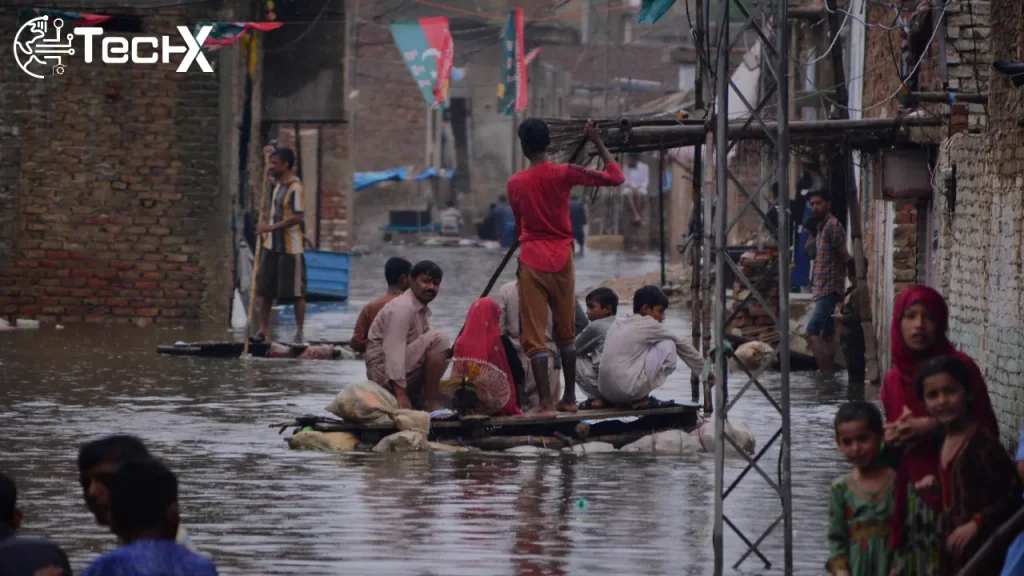Pakistan’s economy has faced a major setback due to the 2025 floods, which caused an estimated loss of $2.9 billion, equal to Rs. 822 billion. Federal Minister for Planning and Development Ahsan Iqbal said the floods damaged large parts of the agriculture and infrastructure sectors. Over 229,000 homes were destroyed, mostly in Punjab, leaving thousands of families displaced and struggling to rebuild their lives.
Findings Presented to the Prime Minister
Speaking at the launch of the Monthly Development Update and Flood Damage Assessment Report, Ahsan Iqbal shared that the findings have been presented to the Prime Minister. He said that inflation has fallen from 9.2% to 4.2%, offering slight relief to citizens. Meanwhile, tax revenues have grown by 12.5% year-on-year, reaching Rs. 2,884 billion during the first quarter of the fiscal year.
Agriculture and Infrastructure Deeply Affected
The minister highlighted that the floods destroyed farmlands, irrigation systems, and key transport routes, disrupting food supply chains and trade. Many farmers lost their crops and livestock, which will take months to recover. Infrastructure damage has also affected rural communities’ access to schools, hospitals, and markets. The government is assessing how much funding will be required to rebuild these essential areas quickly and efficiently.
Also Read: Punjab Govt Pushes for Ban on Rightwing TLP After Muridke Clashes
Pakistan to Rely on Domestic Resources
Ahsan Iqbal stated that Pakistan will depend mainly on domestic resources for recovery efforts rather than waiting for foreign aid. He recalled that after the 2022 floods, the country received only $600 million in foreign support, while the total damage had reached nearly $30 billion. He emphasized that the government has learned from that experience and is now focusing on local strength and resilience.
Plans for Economic Reforms in 2026
Looking forward, Iqbal announced that 2026 will be called the “Year of Reforms and Modernization of the Economy.” The plan aims to bring changes in governance, education, health, and skill development. A National University of Public Administration will be created to train future leaders. Alongside this, the “Uraan Pakistan” program will guide the country toward becoming a $1 trillion economy by 2035.
Relief Efforts Underway Across Provinces
The final flood damage report will be released soon, offering a clearer picture of the total losses. Provincial governments, especially Punjab, are preparing relief packages for affected families. These include housing support, food aid, and financial assistance for farmers. The government aims to ensure that recovery reaches even the most remote regions, helping citizens rebuild their homes, restore livelihoods, and prepare for future climate challenges.
Comparison of the Pakistan Flood of 2024 and 2025
| Category | Pakistan Floods 2024 | Pakistan Floods 2025 |
|---|---|---|
| Estimated Economic Loss | $1.2 billion (Rs. 340 billion) | $2.9 billion (Rs. 822 billion) |
| Homes Damaged | Around 120,000 homes | Over 229,000 homes |
| Worst-Hit Regions | Sindh and Balochistan | Punjab and the southern parts of Pakistan |
| Main Sectors Affected | Agriculture, livestock, and local roads | Agriculture, infrastructure, and housing |
| Rainfall Level | 30% above normal monsoon levels | 45% above normal monsoon levels |
| Government Response | Relied on international donors and aid | Focus on domestic recovery and self-reliance |
| Foreign Aid Received | About $900 million pledged, $450 million received | Only $600 million expected |
| Rehabilitation Timeline | Estimated 12–18 months | Estimated 24 months due to higher damages |
| Inflation After Floods | Rose to 10.5% due to crop damage | Fell from 9.2% to 4.2% due to better planning |
| Future Action Plans | Short-term relief and agricultural recovery | 2026 declared “Year of Reforms” with modernization goals |
| Public Sentiment | Anger over slow relief and corruption | Hopeful due to better management and transparency |
This table clearly shows that while the 2025 floods caused heavier damage, the government’s response has been stronger and more organized. The focus on domestic recovery and reforms in 2026 reflects Pakistan’s determination to build resilience and move toward long-term economic stability.
